Overview of Fountain Grass
Pennisetum species have been reclassified to the genus Cenchurus, though this change has not yet been adopted by all references. Several species of genus are used as ornamental grasses in Wisconsin. Fountain grass, C. alopecuroides, is a perennial ornamental grass, with various cultivars considered hardy to zone 4 or 5. Other species within the genus are not hardy in Wisconsin and are grown as showy annuals, including C. americanus (Pennisetum glaucum) ‘Purple Majesty’ ornamental millet and C. setaceus (P. setaceum), crimson or purple fountain grass, varying in color depending on cultivars, including ‘Rubrum’ (red) and ‘Atrosanguineum’ (purple).
Cenchrus alopecuroides is a warm season perennial grass native to meadows and open woods, alongside streams of Eastern Asia (mainly China and Japan) and Australia. It features finely textured foliage and elegant form, with both leaves and flower spikes swaying in the breeze to add movement to the landscape. Deep green foliage forms a dense but graceful clump 12-48″ tall, depending on the cultivar. Growth is upright at first, then the leaves arch at maturity, resembling a fountain. The length and width of the long, tapering, subtly serrated blades vary greatly among the cultivars. The leaves turn orange-bronze in autumn, eventually fading to a dull beige. The foliage remains fairly upright to provide some winter interest.
In late summer showy, white to pink, copper or purple flower spikes are produced above the leaves. The flowers are concentrated in the narrow bottle-brush form on the end of the spike and seeds are hidden within the bristles of the fuzzy-looking inflorescences. Fountain grass flower spikes are particularly dramatic when backlit, so try to position the plants to take advantage of the sun behind them. The plants may not bloom when the growing season is very short. The inflorescences do not last the entire winter, only holding together for a few months as the seeds begin to shatter after a few hard freezes.
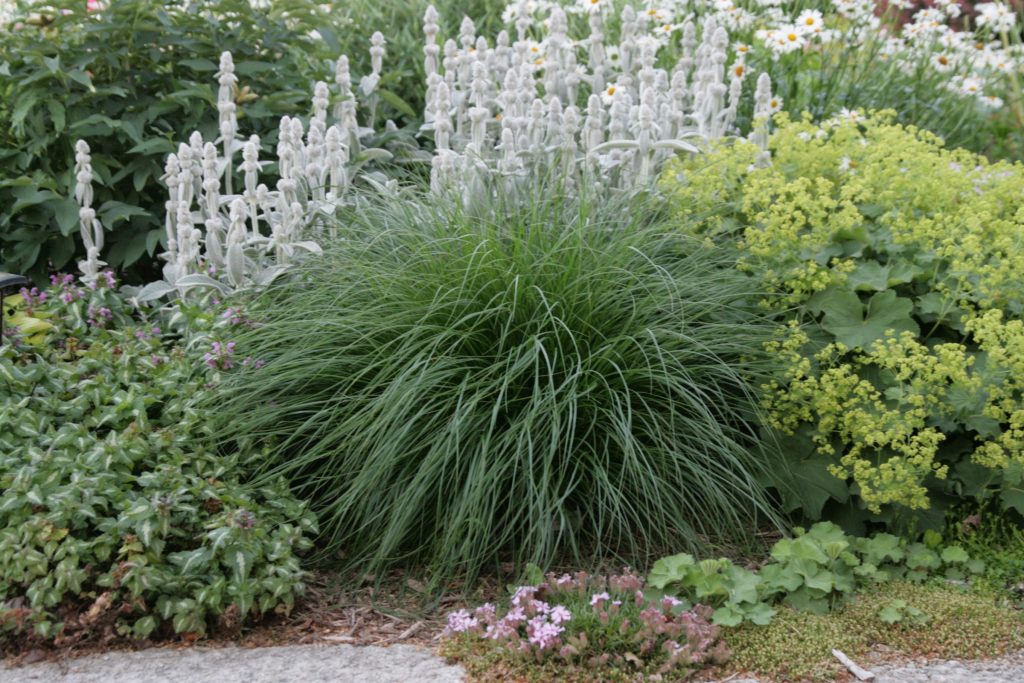
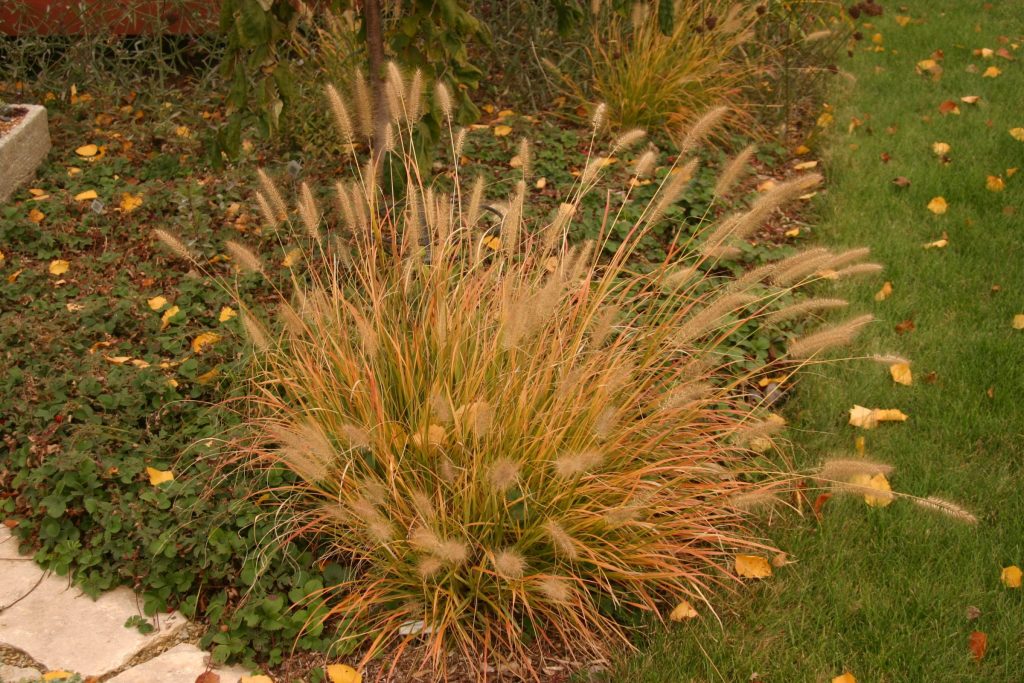
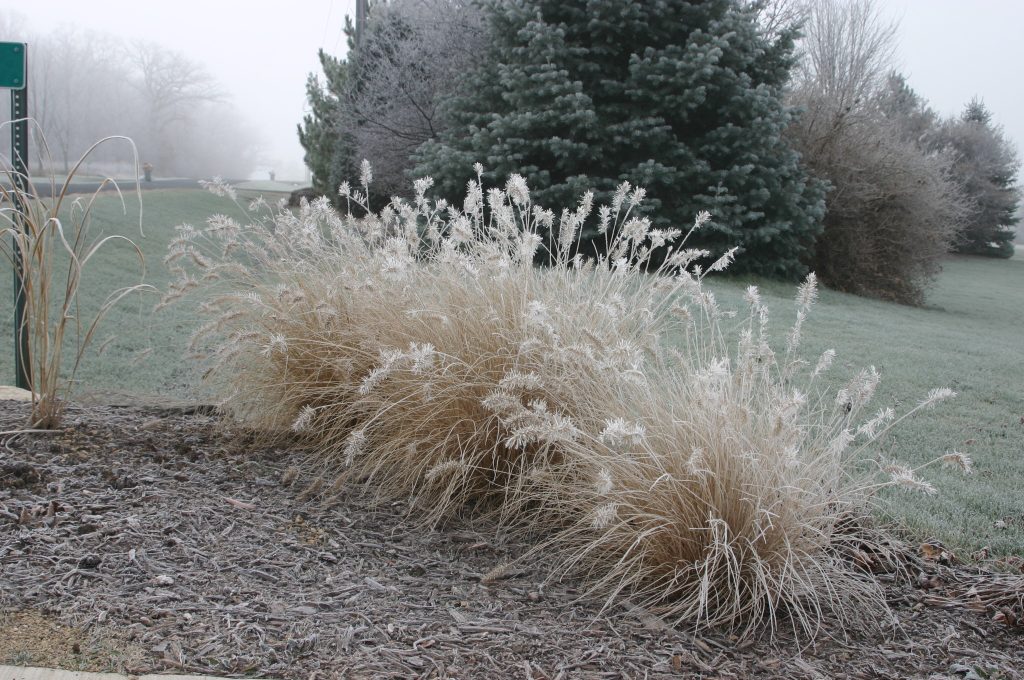
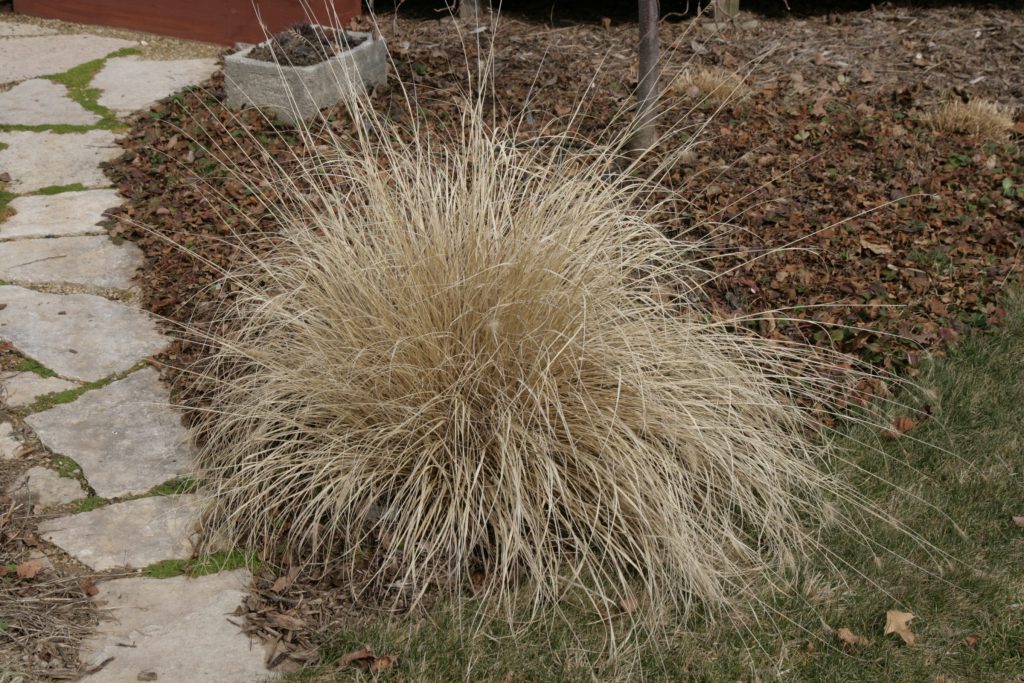
General Care of Fountain Grass
Fountain grass is easily grown in most soils and does best in full sun, although it does tolerate part shade (but will not flower well). Although it prefers fairly dry soils and is drought tolerant once established, it also grows in moist, but well-drained soils. Plant the grass with the crown of the plant above ground level to prevent crown rot, especially in very moist situations. It may decline in very wet years or poorly drained soils. The tips of the leaves may turn brown if not watered in drought conditions. Even though listed as zone 4, fountain grass is marginally hardy in zone 4 and northern areas of zone 5, with large portions of crowns dying out in some winters, leaving lopsided or misshapen plants. Fountain grass has few pest problems and are considered deer resistant.
As with other warm season grasses, C. alopecuroides doesn’t start growing each year until conditions warm considerably, giving time after winter ends to trim the previous year’s growth before the new shoots appear. Trim the grass to 3-6″ above the ground. This can easily be done with hedge trimmers, especially if the clumps are tied up with string first. As individual clumps age the center of the plant often dies out, forming an open ring, indicating a need to divide them. Divide and replant after shearing to rejuvenate clumps. Typically, division is suggested every three years based on growth pattern.
Landscape Use
Use fountain grass as a specimen plant or focal point in smaller areas. In large gardens use plants individually or in small groups with perennials and shrubs to provide a contrast of texture or massed in large groups as a tall ground cover. Fountain grass is better suited for residential landscapes than many other ornamental grasses because of its moderate size, and works well in rock gardens, fronts of borders, and around water gardens, streams or ponds. It has a particularly beautiful effect when reflected in water. Some people feel it looks weedy early in the season before the inflorescences appear but others like its soft, fine texture and movement in the breeze at all stages of growth. Fountain grass makes a good informal edging along hardscapes or to soften the edges of paths. Try planting near lady’s mantle (Alchemilla mollis) or purple cultivars of Heuchera for dramatic contrast. It provides a good foil for variegated plants, such as low-growing Lamium maculatum ‘Anne Greenaway’ or ‘Pink Nancy’ or a taller shrub like ‘Carol Mackie’ Daphne.
Propagating Fountain Grass
Fountain grass can be grown from seed – and many types self-seed readily (to the point of being weedy), but do not always come true from seed. In colder climates this species never becomes invasive like it can in warmer areas. Sow seeds in early spring, barely covering the seed. Transplant into the permanent position in the garden in summer. Plants are also easily propagated by division in spring as growth begins.
Cultivars of Fountain Grass
- ‘Cassian’ has dusky brown flowers and rich golden fall color with orange-red tints. It is about the same size as the more common ‘Hameln’, although its leaves are coarser, with some red tinting under the right environmental conditions. It was named for German horticulturist Cassian Schmidt. It is rated as zone 5/6.
- ‘Fox Trot’ is listed as hardy to zone 4. It is much taller, with more rosy- or black-colored inflorescences.
- ‘Hameln’ is one of the hardiest cultivars, rated at zone 5, but often seen growing in zone 4 gardens. It is more compact than the species (18-24″ tall and wide), with bright green foliage and silvery-white flowers that bloom about 2 weeks earlier than the species. It does not reseed as prolifically as the species and many other cultivars. It is the most commonly available cultivar in the nursery trade.
- ‘Hush Puppy’ is a sterile, long blooming variety that grows 3 to 3.5 feet tall. It was developed at the University of Georgia by Wayne Hanna.
- ‘Little Bunny’ is a super dwarf form only about a foot tall. It flowers lightly but more or less continuously from mid-summer (up to 2 months earlier than the species). The flowers are light green in the small inflorescences that resemble bunny tails. It is particularly useful in gardens with limited space.
- ‘Little Honey’ is a variegated sport of ‘Little Bunny’ with green leaves with a fine white margin. It is even smaller than ‘Little Bunny’ but is still quite vigorous, with miniature tan plumes 6-12″ tall. It needs a special site, such as in the rock garden, so that it won’t get lost in the landscape.
- ‘Moudry’ (often called black fountain grass) has deep maroon flowers produced 3-5 weeks later in the season than the species. The plant is vigorous, growing to 2½ -3 feet tall and wide, with wider leaves and more upright inflorescences than the other types. It is a prolific seeder in warmer climates and is not as hardy as many of the other cultivars, often rated only zone 6. It was introduced by the National Arboretum from a batch of Japanese seeds.
- ‘National Arboretum’, an introduction of the U. S. National Arboretum, is similar to ‘Moudry’ with dark, almost black inflorescences late in the season, but has better flowering. Like ‘Moudry’ it has a tendency to self seed prolifically in warmer climates and is hardy to zone 6a (and possibly zone 5b).
- ‘Redhead’, a selection from seedlings of ‘National Arboretum’, has big, smoky burgundy inflorescences and blooms earlier than the parent type. It is hardy to zone 5b or 6a.
- ‘Weserbergland’ is another dwarf type, growing 2-3 feet tall.
– Susan Mahr, University of Wisconsin – Madison
Last Update: Bruce Spangenberg, UW-Madison Extension, 2025

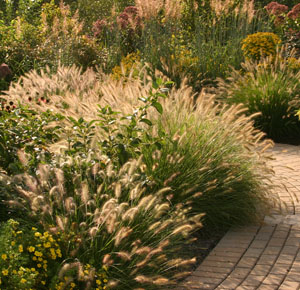

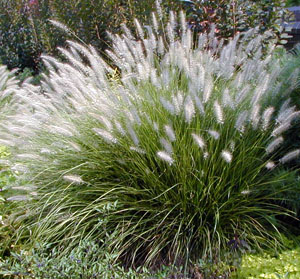
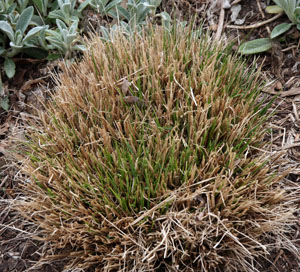
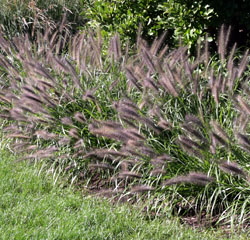


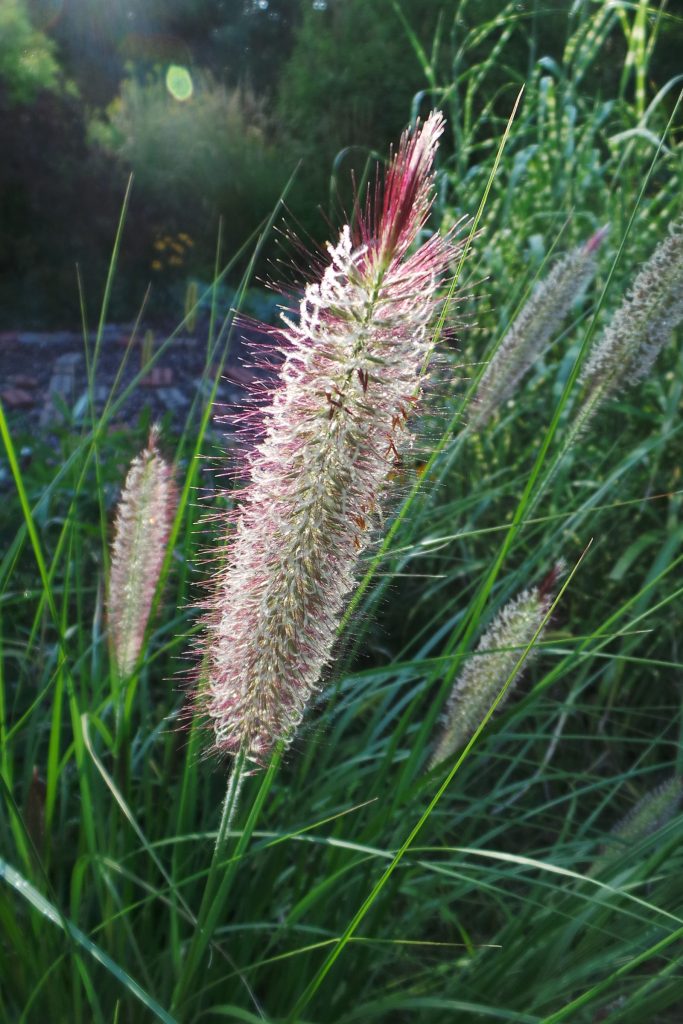




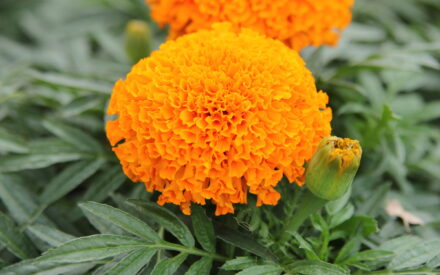 Marigolds
Marigolds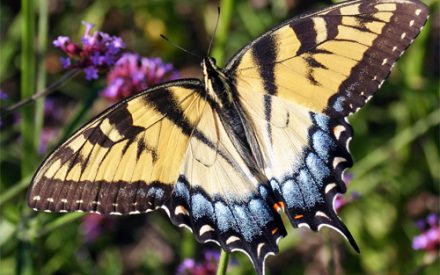 Create a Butterfly Garden
Create a Butterfly Garden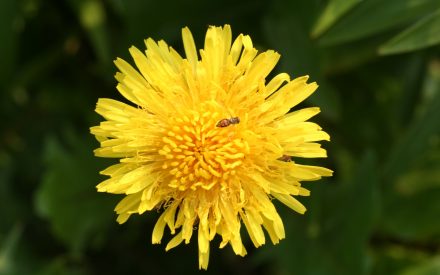 Plant Flowers to Encourage Beneficial Insects
Plant Flowers to Encourage Beneficial Insects Forcing Bulbs
Forcing Bulbs


